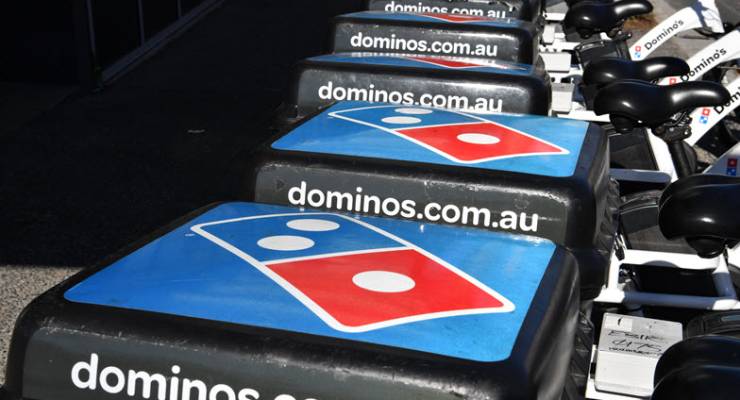
Well, that escalated quickly. In the space of a week, the CEO of Australia’s largest company has announced he’ll resign and a former market darling has turned into a villain. The share price of Domino’s, which only two years ago was valued at around $8 billion by the market, has fallen by almost 50%, wiping around $800 million from the wealth of its chairman, “Hungry” Jack Cowin, and $100 million from the bank balance of CEO Don Meij. On Tuesday alone more than 20% or $1 billion was wiped from the high-tech pizza franchisor’s market capitalisation.
The cause of Domino’s rapid fall was a worse-than-expected profit announcement, with Meij telling investors that the company would grow earnings by only 28% in 2017. While most companies would give their right leg for that sort of growth, Domino’s announcement went down about as well as a salmonella-laced Hawaiian pizza for numerous reasons.
First, in February, Meij assured the market that growth would be more than 30% and the market hates it when companies miss earnings forecasts. Second, Domino’s trades on an eye-wateringly high “multiple”. That is, investors pay a high amount for each dollar of profit Domino’s earns because they expect the company to be earning a lot more profit in future years. In basic terms that means the bar is set very high — fail to meet the inflated expectations, and speculators (there aren’t too many “investors” who bought Domino’s shares) run for the hills. Third, there are real questions over the sustainability of Domino’s business model. Fourth, actual growth, measured by “same store” sales (and effectively excluding acquisitions) was a far more tepid 14%. Fifth, Domino’s earnings seem somewhat dubious, with one-off profits from converting corporate stores to franchised stores and switching from Coke to Pepsi that goosed short-term earnings. Finally, Meij told investors that growth would be a far more tepid 20% next year. Ouch.
Aside from the dubious earnings number, the key issue facing Domino’s is the viability of its model going forward. Meij took Domino’s share price from $2 in 2005 to as high as $80, largely based on undercutting rivals like Pizza Hut on price and providing some neat technology gimmicks like GPS tracking of deliveries. The tech gimmicks have largely been replicated by a myriad competitors like Uber Eats, Foodora and Deliveroo and a slight tech lead is not, in the eyes of most venture investors, a key competitive advantage in any event. The other problem for Domino’s is that it effectively has two key stakeholders: customers and franchisees. And the two conflict.
To make customers happy (and continue to grow earnings), Domino’s needs to offer rock-bottom prices. But continuing to lower prices inevitably reduces the profit margins of franchisees (you can’t sell pizzas for $2 and make much profit). To overcome this problem, Domino’s provided superior technology and as was revealed in February, a portion of franchisees were underpaying staff. This is now being rectified, but it means that the profit being generated by franchisees is being squeezed. Inevitably, this will reduce Domino’s profits, as a model based on illegally underpaying staff and trying to maintain a tech advantage is unsustainable. This appears to already be playing out, with Domino’s noting that loans to franchisees increased last year from $37.5 million to $57.5 million. The success of a franchising system like Domino’s or McDonald’s is based on its franchisees being able to make significant profits — while it’s slightly less of a direct link than a traditional corporate structure, ignoring the struggles of franchisees is bound to lead to disaster.
Meanwhile, the company appears to be exacerbating the problem by conducting a $300 million share buyback of what appears to still be vastly overvalued scrip. As Warren Buffet noted back in 2012: “I favour repurchases when two conditions are met: first, a company has ample funds to take care of the operational and liquidity needs of its business; second, its stock is selling at a material discount to the company’s intrinsic business value, conservatively calculated.” It is hard to imagine that Domino’s, even after it’s 50% share price collapse, is selling at a discount to its intrinsic value.
While the party certainly appears over, Meij and Cowan can certainly take credit for building a profitable Australian company (it might be grossly overpriced, but Domino’s still generated $118 million in profit last year). Those who can’t take credit is the idiotic cabal of Australian fund managers who continued to back the stock, despite growing calls from short sellers and the wage underpayment debacle.
And perhaps this is the story here. No other industry would pay so much for poor performance other than the fund management sector. The handful of respected fund managers (like Peter Cooper, David Paradise, Hamish Douglass, Kerr Neilson and Dion Hershan) are offered tens of millions annually to do their job reasonably competently. However, they appear to be geniuses because most fund managers are incompetent bozos who charge a fortune in fees to underperform the market. Adam Creighton noted earlier this year, the average Australian fund manager returned only 9.2% last year, compared with 12% for the S&P/ASX200. A quarter of fund managers returned less than half the market.
That means investors are literally paying someone to perform badly. It’s a bit like paying $100 for a taxi to get to a football game on time, only for the $2 train to get there half an hour earlier.
This is hardly a new issue, and it is exacerbated by Australia’s compulsory superannuation laws forcing hundreds of billions of dollars into the pockets of fund managers literally so stupid, they would be materially outperformed by that drinking bird who once replaced Homer Simpson.
The short sellers who shrewdly observed that the Domino’s facade would come crashing down are to be commended. Like they did at Slater & Gordon and Bellamy’s and Myer and Dick Smith, the short sellers outsmarted the fund managers who continue to misallocate our capital in the worst possible way.
*Adam Schwab is the author of Pigs at the Trough: Lessons from Australia’s Decade of Corporate Greed








Could the writer of this sentence: “Aside from the dubious earnings number, the key issue facing Domino’s is the viability of its model going forward. ”
please tell me what the viability of its model would be going backward?
“Going forward” is bizspeak for “in future”. Do try to keep up.
I thought I was supposed to “reach out” going forward, but tell me, how much sense does it make to use “going forward”, or “in the future” or any other equivalent term? Could you tell me about the viability of the business model “going backward”? My point, which I’m insufficiently businesslike to make in a form that’s understood by you, is that “going forward” is not just superfluous, but nonsensical. Does that make business sense?
Re garbled text & typos, the score for cReiky today is at least 4, mostly curse of W/P as phrases are moved about but syntax not altered to suit.
I don’t read some sections, like the TV ratings, so there may be more.